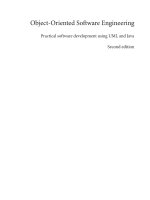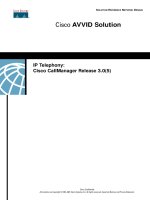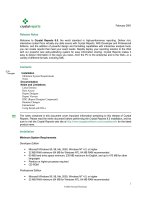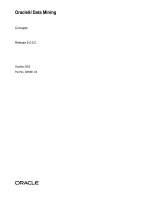Release engineering
Bạn đang xem bản rút gọn của tài liệu. Xem và tải ngay bản đầy đủ của tài liệu tại đây (1.41 MB, 29 trang )
Web Ops
Release Engineering
How Google Builds and Delivers Software
Dinah McNutt
Release Engineering
by Dinah McNutt
Copyright © 2016 O’Reilly Media, Inc. All rights reserved.
Printed in the United States of America.
Published by O’Reilly Media, Inc., 1005 Gravenstein Highway North,
Sebastopol, CA 95472.
O’Reilly books may be purchased for educational, business, or sales
promotional use. Online editions are also available for most titles
(). For more information, contact our
corporate/institutional sales department: 800-998-9938 or
Editors: Brian Anderson and
Virginia Wilson
Production Editor: Kristen Brown
Copyeditor: Kim Cofer
Interior Designer: David Futato
Cover Designer: Karen Montgomery
Illustrator: Rebecca Demarest
June 2016: First Edition
Revision History for the First Edition
2016-06-10: First Release
The O’Reilly logo is a registered trademark of O’Reilly Media, Inc. Release
Engineering, the cover image, and related trade dress are trademarks of
O’Reilly Media, Inc.
While the publisher and the author have used good faith efforts to ensure that
the information and instructions contained in this work are accurate, the
publisher and the author disclaim all responsibility for errors or omissions,
including without limitation responsibility for damages resulting from the use
of or reliance on this work. Use of the information and instructions contained
in this work is at your own risk. If any code samples or other technology this
work contains or describes is subject to open source licenses or the
intellectual property rights of others, it is your responsibility to ensure that
your use thereof complies with such licenses and/or rights.
978-1-491-96521-4
[LSI]
Release Engineering
Written by Dinah McNutt
Edited by Betsy Beyer and Tim Harvey
Release engineering is a relatively new and fast-growing discipline of
software engineering that can be concisely described as building and
delivering software.1 Release engineers have a solid (if not expert)
understanding of source code management, compilers, build configuration
languages, automated build tools, package managers, and installers. Their
skill set includes deep knowledge of multiple domains: development,
configuration management, test integration, system administration, and
customer support.
Running reliable services requires reliable release processes. Site Reliability
Engineers (SREs) need to know that the binaries and configurations they use
are built in a reproducible, automated way so that releases are repeatable and
aren’t “unique snowflakes.” Changes to any aspect of the release process
should be intentional, rather than accidental. SREs care about this process
from source code to deployment.
Release engineering is a specific job function at Google. Release engineers
work with software engineers (SWEs) in product development and SREs to
define all the steps required to release software — from how the software is
stored in the source code repository, to build rules for compilation, to how
testing, packaging, and deployment are conducted.
The Role of a Release Engineer
Google is a data-driven company and release engineering follows suit. We
have tools that report on a host of metrics, such as how much time it takes for
a code change to be deployed into production (in other words, release
velocity) and statistics on what features are being used in build configuration
files.2 Most of these tools were envisioned and developed by release
engineers.
Release engineers define best practices for using our tools in order to make
sure projects are released using consistent and repeatable methodologies. Our
best practices cover all elements of the release process. Examples include
compiler flags, formats for build identification tags, and required steps during
a build. Making sure that our tools behave correctly by default and are
adequately documented makes it easy for teams to stay focused on features
and users, rather than spending time reinventing the wheel (poorly) when it
comes to releasing software.
Google has a large number of SREs who are charged with safely deploying
products and keeping Google services up and running. In order to make sure
our release processes meet business requirements, release engineers and
SREs work together to develop strategies for canarying changes, pushing out
new releases without interrupting services, and rolling back features that
demonstrate problems.
Philosophy
Release engineering is guided by an engineering and service philosophy
that’s expressed through four major principles, detailed in the following
sections.
Self-Service Model
In order to work at scale, teams must be self-sufficient. Release engineering
has developed best practices and tools that allow our product development
teams to control and run their own release processes. Although we have
thousands of engineers and products, we can achieve a high release velocity
because individual teams can decide how often and when to release new
versions of their products. Release processes can be automated to the point
that they require minimal involvement by the engineers, and many projects
are automatically built and released using a combination of our automated
build system and our deployment tools. Releases are truly automatic, and
only require engineer involvement if and when problems arise.
High Velocity
User-facing software (such as many components of Google Search) is rebuilt
frequently, as we aim to roll out customer-facing features as quickly as
possible. We have embraced the philosophy that frequent releases result in
fewer changes between versions. This approach makes testing and
troubleshooting easier. Some teams perform hourly builds and then select the
version to actually deploy to production from the resulting pool of builds.
Selection is based upon the test results and the features contained in a given
build. Other teams have adopted a “Push on Green” release model and deploy
every build that passes all tests.3
Hermetic Builds
Build tools must allow us to ensure consistency and repeatability. If two
people attempt to build the same product at the same revision number in the
source code repository on different machines, we expect identical results.4
Our builds are hermetic, meaning that they are insensitive to the libraries and
other software installed on the build machine. Instead, builds depend on
known versions of build tools, such as compilers, and dependencies, such as
libraries. The build process is self-contained and must not rely on services
that are external to the build environment.
Rebuilding older releases when we need to fix a bug in software that’s
running in production can be a challenge. We accomplish this task by
rebuilding at the same revision as the original build and including specific
changes that were submitted after that point in time. We call this tactic cherry
picking. Our build tools are themselves versioned based on the revision in the
source code repository for the project being built. Therefore, a project built
last month won’t use this month’s version of the compiler if a cherry pick is
required, because that version may contain incompatible or undesired
features.
Enforcement of Policies and Procedures
Several layers of security and access control determine who can perform
specific operations when releasing a project. Gated operations include:
Approving source code changes — this operation is managed through
configuration files scattered throughout the codebase
Specifying the actions to be performed during the release process
Creating a new release
Approving the initial integration proposal (which is a request to perform
a build at a specific revision number in the source code repository) and
subsequent cherry picks
Deploying a new release
Making changes to a project’s build configuration
Almost all changes to the codebase require a code review, which is a
streamlined action integrated into our normal developer workflow. Our
automated release system produces a report of all changes contained in a
release, which is archived with other build artifacts. By allowing SREs to
understand what changes are included in a new release of a project, this
report can expedite troubleshooting when there are problems with a release.
Continuous Build and Deployment
Google has developed an automated release system called Rapid. Rapid is a
system that leverages a number of Google technologies to provide a
framework that delivers scalable, hermetic, and reliable releases. The
following sections describe the software lifecycle at Google and how it is
managed using Rapid and other associated tools.
Building
Blaze5 is Google’s build tool of choice. It supports building binaries from a
range of languages, including our standard languages of C++, Java, Python,
Go, and JavaScript. Engineers use Blaze to define build targets (e.g., the
output of a build, such as a JAR file), and to specify the dependencies for
each target. When performing a build, Blaze automatically builds the
dependency targets.
Build targets for binaries and unit tests are defined in Rapid’s project
configuration files. Project-specific flags, such as a unique build identifier,
are passed by Rapid to Blaze. All binaries support a flag that displays the
build date, the revision number, and the build identifier, which allow us to
easily associate a binary to a record of how it was built.
Branching
All code is checked into the main branch of the source code tree (mainline).
However, most major projects don’t release directly from the mainline.
Instead, we branch from the mainline at a specific revision and never merge
changes from the branch back into the mainline. Bug fixes are submitted to
the mainline and then cherry picked into the branch for inclusion in the
release. This practice avoids inadvertently picking up unrelated changes
submitted to the mainline since the original build occurred. Using this branch
and cherry pick method, we know the exact contents of each release.
Testing
A continuous test system runs unit tests against the code in the mainline each
time a change is submitted, allowing us to detect build and test failures
quickly. Release engineering recommends that the continuous build test
targets correspond to the same test targets that gate the project release. We
also recommend creating releases at the revision number (version) of the last
continuous test build that successfully completed all tests. These measures
decrease the chance that subsequent changes made to the mainline will cause
failures during the build performed at release time.
During the release process, we re-run the unit tests using the release branch
and create an audit trail showing that all the tests passed. This step is
important because if a release involves cherry picks, the release branch may
contain a version of the code that doesn’t exist anywhere on the mainline. We
want to guarantee that the tests pass in the context of what’s actually being
released.
To complement the continuous test system, we use an independent testing
environment that runs system-level tests on packaged build artifacts. These
tests can be launched manually or from Rapid.
Packaging
Software is distributed to our production machines via the Midas Package
Manager (MPM).6 MPM assembles packages based on Blaze rules that list
the build artifacts to include, along with their owners and permissions.
Packages are named (e.g., search/shakespeare/frontend), versioned with a
unique hash, and signed to ensure authenticity. MPM supports applying
labels to a particular version of a package. Rapid applies a label containing
the build ID, which guarantees that a package can be uniquely referenced
using the name of the package and this label.
Labels can be applied to an MPM package to indicate a package’s location in
the release process (e.g., dev, canary, or production). If you apply an
existing label to a new package, the label is automatically moved from the old
package to the new package. For example: if a package is labeled as
canary, someone subsequently installing the canary version of that package
will automatically receive the newest version of the package with the label
canary.
Rapid
Figure 1-1 shows the main components of the Rapid system. Rapid is
configured with files called blueprints. Blueprints are written in an internal
configuration language and are used to define build and test targets, rules for
deployment, and administrative information (like project owners). Role-based
access control lists determine who can perform specific actions on a Rapid
project.
Figure 1-1. Simplified view of Rapid architecture showing the main components of the system
Each Rapid project has workflows that define the actions to perform during
the release process. Workflow actions can be performed serially or in
parallel, and a workflow can launch other workflows. Rapid dispatches work
requests to tasks running as a Borg job on our production servers. Because
Rapid uses our production infrastructure, it can handle thousands of release
requests simultaneously.
A typical release process proceeds as follows:
1. Rapid uses the requested integration revision number (often obtained
automatically from our continuous test system) to create a release
branch.
2. Rapid uses Blaze to compile all the binaries and execute the unit
tests, often performing these two steps in parallel. Compilation and
testing occur in environments dedicated to those specific tasks, as
opposed to taking place in the Borg job where the Rapid workflow is
executing. This separation allows us to parallelize work easily.
3. Build artifacts are then available for system testing and canary
deployments. A typical canary deployment involves starting a few
jobs in our production environment after the completion of system
tests.
4. The results of each step of the process are logged. A report of all
changes since the last release is created.
Rapid allows us to manage our release branches and cherry picks; individual
cherry pick requests can be approved or rejected for inclusion in a release.
Deployment
Rapid is often used to drive simple deployments directly. It updates the Borg
jobs to use newly built MPM packages based on deployment definitions in
the blueprint files and specialized task executors.
For more complicated deployments, we use Sisyphus, which is a generalpurpose rollout automation framework developed by SRE. A rollout is a
logical unit of work that is composed of one or more individual tasks.
Sisyphus provides a set of Python classes that can be extended to support any
deployment process. It has a dashboard that allows for finer control on how
the rollout is performed and provides a way to monitor the rollout’s progress.
In a typical integration, Rapid creates a rollout in a long-running Sisyphus
job. Rapid knows the build label associated with the MPM package it created,
and can specify that build label when creating the rollout in Sisyphus.
Sisyphus uses the build label to specify which version of the MPM packages
should be deployed.
With Sisyphus, the rollout process can be as simple or complicated as
necessary. For example, it can update all the associated jobs immediately or it
can roll out a new binary to successive clusters over a period of several hours.
Our goal is to fit the deployment process to the risk profile of a given service.
In development or pre-production environments, we may build hourly and
push releases automatically when all tests pass. For large user-facing
services, we may push by starting in one cluster and expand exponentially
until all clusters are updated. For sensitive pieces of infrastructure, we may
extend the rollout over several days, interleaving them across instances in
different geographic regions.
Configuration Management
Configuration management is one area of particularly close collaboration
between release engineers and SREs. Although configuration management
may initially seem a deceptively simple problem, configuration changes are a
potential source of instability. As a result, our approach to releasing and
managing system and service configurations has evolved substantially over
time. Today we use several models for distributing configuration files, as
described in the following paragraphs. All schemes involve storing
configuration in our primary source code repository and enforcing a strict
code review requirement.
Use the mainline for configuration. This was the first method used to
configure services in Borg (and the systems that pre-dated Borg). Using this
scheme, developers and SREs modify configuration files at the head of the
main branch. The changes are reviewed and then applied to the running
system. As a result, binary releases and configuration changes are decoupled.
While conceptually and procedurally simple, this technique often leads to
skew between the checked-in version of the configuration files and the
running version of the configuration file because jobs must be updated in
order to pick up the changes.
Include configuration files and binaries in the same MPM package. For
projects with few configuration files or projects where the files (or a subset of
files) change with each release cycle, the configuration files can be included
in the MPM package with the binaries. While this strategy limits flexibility
by binding the binary and configuration files tightly, it simplifies
deployment, because it only requires installing one package.
Package configuration files into MPM “configuration packages.” We can
apply the hermetic principle to configuration management. Binary
configurations tend to be tightly bound to particular versions of binaries, so
we leverage the build and packaging systems to snapshot and release
configuration files alongside their binaries. Similar to our treatment of
binaries, we can use the build ID to reconstruct the configuration at a specific
point in time.
For example, a change that implements a new feature can be released with a
flag setting that configures that feature. By generating two MPM packages,
one for the binary and one for the configuration, we retain the ability to
change each package independently. That is, if the feature was released with
a flag setting of first_folio but we realize it should instead be
bad_quarto, we can cherry pick that change onto the release branch,
rebuild the configuration package, and deploy it. This approach has the
advantage of not requiring a new binary build.
We can leverage MPM’s labeling feature to indicate which versions of MPM
packages should be installed together. A label of much_ado can be applied
to the MPM packages described in the previous paragraph, which allows us
to fetch both packages using this label. When a new version of the project is
built, the much_ado label will be applied to the new packages. Because
these tags are unique within the namespace for an MPM package, only the
latest package with that tag will be used.
Read configuration files from an external store. Some projects have
configuration files that need to change frequently or dynamically (i.e., while
the binary is running). These files can be stored in Chubby, Bigtable, or our
source-based filesystem.7
In summary, project owners consider the different options for distributing and
managing configuration files and decide which works best on a case-by-case
basis.
Conclusions
While this report has specifically discussed Google’s approach to release
engineering and the ways in which release engineers work and collaborate
with SREs, these practices can also be applied more widely.
It’s Not Just for Googlers
When equipped with the right tools, proper automation, and well-defined
policies, developers and SREs shouldn’t have to worry about releasing
software. Releases can be as painless as simply pressing a button.
Most companies deal with the same set of release engineering problems
regardless of their size or the tools they use: How should you handle
versioning of your packages? Should you use a continuous build and deploy
model, or perform periodic builds? How often should you release? What
configuration management policies should you use? What release metrics are
of interest?
Google Release Engineers have developed our own tools out of necessity
because open sourced or vendor-supplied tools don’t work at the scale we
require. Custom tools allow us to include functionality to support (and even
enforce) release process policies. However, these policies must first be
defined in order to add appropriate features to our tools, and all companies
should take the effort to define their release processes whether or not the
processes can be automated and/or enforced.









